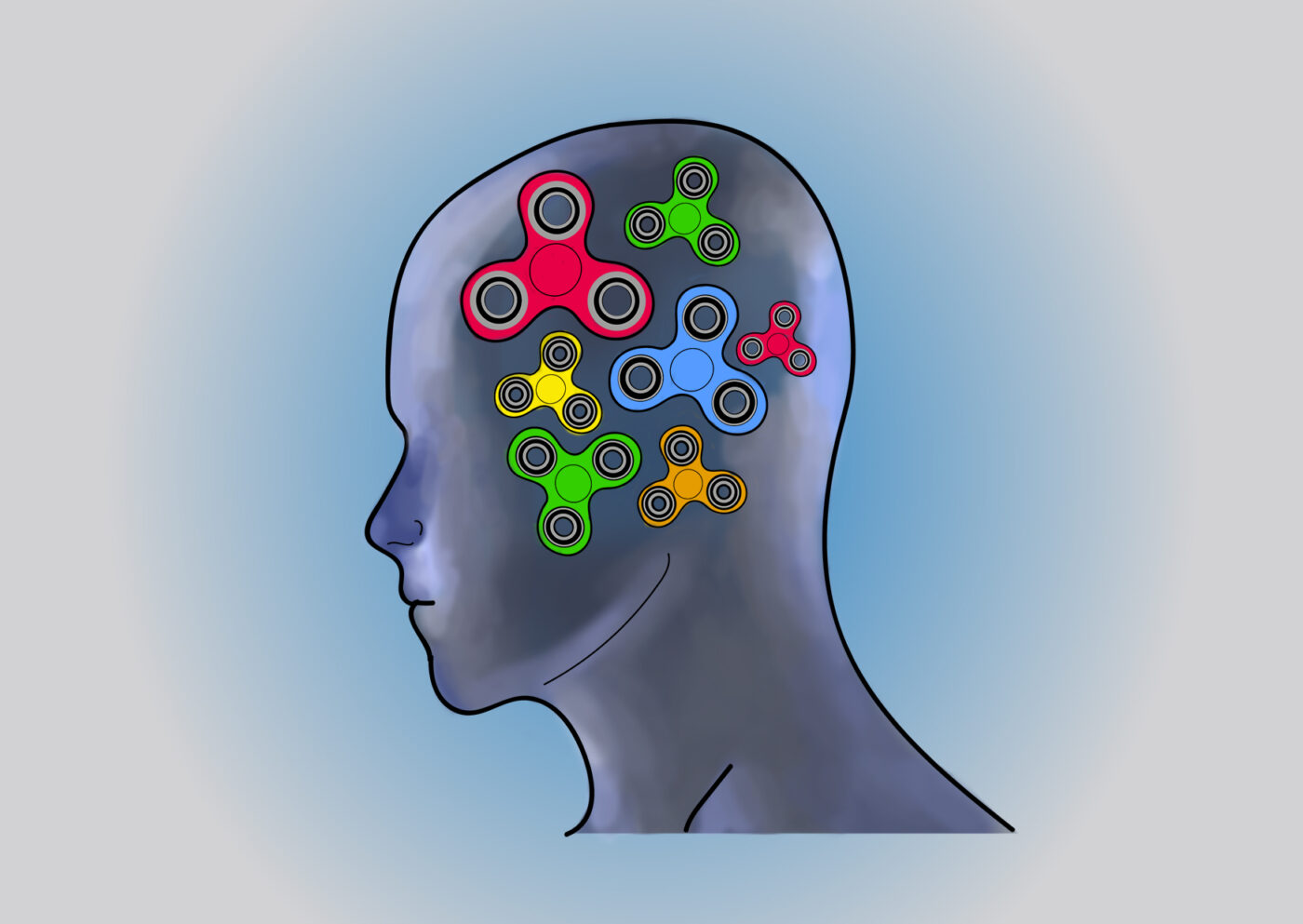The apparent antidote for drifting focus is the latest trendy item in every other person’s hand.
Somewhere in the confines of a college campus, a professor is in the middle of a lecture. Thirty or so university students sit in varying degrees of inattention. The professor’s monologue mingles with a cacophony of distracted gestures.
Some are clicking pens, others are tapping fingers, and suddenly the sound of a fidget spinner being spun again and again joins the dissonance of the students’ distracted actions. The latter sound piques the curiosity of onlookers, and the spinning colors draw eyes away from the whiteboard. Suddenly, in a room full of adults, a child’s plaything is the center of attention.
The boom of fidget spinners and fidget cubes a few months ago has caused a mixture of responses. In fact, the very nature of these fidget spinners and fidget cubes is one of the biggest points of inquiry: are they toys or are they tools for better concentration? Many have claimed that they are more of the latter, but this just brings to light questions of their exact function and more importantly, their practicality.
The drawing board
The beginnings of the fidget spinner are as of now, uncertain. The Guardian and The New York Times have dubbed Catherine Hettinger, 62 years old and a chemical engineer by training, as the inventor of the device, but there is yet to be a clear verdict. A self-proclaimed “tinkerer,” Hettinger filed for a patent for a similar device in 1997. The device was a “spinning toy” that had the appearance of a frisbee or of an unidentified flying object (UFO).
However, patent experts from intellectual property firm, Merchant & Gould, have since stated that Hettinger’s patent does not cover the aspects of the fidget spinners in current production. The only similarity they have is the fact that they both spin.
On the other hand, fidget cubes, which are now as popular as fidget spinners, have recently been licensed off to the award-winning toy developer Zuru. The fidget cube’s original inventors, Matthew and Mark McLachlan, previously raised approximately USD 6.4 million in late 2016 through Kickstarter, an online crowdfunding platform. They described the cube as “an unusually addicting, high-quality desk toy designed to help you focus.”
Nevertheless, the depiction of fidget toys as fads–as opposed to legitimate sensory toys– hasn’t stopped English literature junior Angelica Patricia Suacillo. After a recommendation from her Psychology professor, Suacillo has used her fidget cube as a tool to hone concentration.
“I’ve been diagnosed with ADHD, and a lot of times, it gets really hard for me to concentrate in class,” she said. Suacillo shares that she hasn’t had any sensory toys prior to using a fidget toy. “I’ve been using my fidget cube for six months. [It] really helps me focus on classes and on work more.”
Questionable aid
The utilization of toys to preoccupy people, particularly those diagnosed with Attention Deficit Hyperactivity Disorder (ADHD), is not a new idea. Individuals with this neurological condition have difficulty maintaining attention and controlling impulsive and hyperactive behavior.
To temper these behaviors, some medical professionals employ “sensory toys,” a broad term for any apparatus that aids in concentration and lessens hyperactivity. Examples of these are playdough, noise-making toys such as clappers or clackers, and stress balls.
But do fidget spinners and cubes fit this description? In some aspects, the answer is yes. In terms of design, the similarities between sensory and fidget toys are abundant and easy to draw. Both are designed to be manipulated by hand and both preoccupy their users’ senses for better concentration. The resemblance even extends to the material used. Both are generally fashioned from cheap plastic, making them easy to procure.
With this much overlap, it is easy to generalize fidget toys as sensory toys and call it a day. University students have even used fidget toys for purposes very similar to sensory toys. Maintaining focus in the stressful classroom environment can be difficult, and fidget toys are an accessible remedy.
In the Philippines, the fidget toys’ attractive price tag may turn out to be a boon to special needs kids who cannot commit to expensive, long-term therapy. According to research from the Los Baños Times, rates for a single therapy session range from Php 500 to 700. In comparison, a fidget toy is a one-off purchase and costs a pittance.
However, some experts such as psychologist Mark Rapport voice caution. “Without studies that specifically look at fidget spinners, it’s impossible to say for sure whether the devices could help kids with ADHD,” he told LiveScience. Unlike time-tested sensory toys, “using a spinner-like gadget is more likely to serve as a distraction,” implying that fidget toys will not achieve the permanence of sensory toys in psychology.
“The spinning attracts other children’s attention,” says occupational therapist Peggy Morris, who treats people with sensory issues. A useful fidget toy, she argues, should not distract the user from the task at hand. “If the child is attending to the fidget and not involved in their work, [it is] not a success.” Fidget toys, therefore, cannot be credibly called sensory toys, uncanny resemblances aside.
A fading fad
This lack of scientific evidence then begs the question: If fidget spinners and cubes are not sensory toys, then what exactly are they?
Sociologist Joel Best says he has the answer. Writing for CNN, Best argues that fidget toys are but another entry into a long line of children’s fads. “Available in all sorts of color schemes, many children carry around a pocketful.” The sociologist likened fidget spinners, and their “cousin” fidget cubes, to the hula hoop fad in the late 1950s. After selling an estimated 25 M, hula hoops “soon stopped spinning and began collecting dust.” In June, fidget toys held 49 out of 50 spots of the top children’s toys in Amazon.
There are signs, however, that fidget toys will soon go the way the hula hoop has gone. Speaking to TIME magazine, financial analyst Bradley Thomas believes that the fidget spinner has reached its peak, according to his analysis of Amazon purchases and Google search trends. “The toy has reached a plateau.”
Computational Media Professor Katherine Ibister, from University of California, Santa Cruz, has dubbed the fidget cube more “classroom friendly.” Unlike its spinning cousin, the cube does not attract visual attention away from classroom focus.
The popularization of fidget toys has helped alleviate pressure on individuals with special needs. And as adults with no formal diagnoses use the fidget toy more frequently, its use has been normalized.
Which is, perhaps, exactly where the heart of this matter lies. The practicality of fidget toys vary from person to person. Although the fidget cube may have worked for Suacillo, there’s no guarantee that it will work for everyone. The endless debate on whether fidget toys are effective tools for concentration is an inquiry that can simply be answered in two words: “It depends.”







